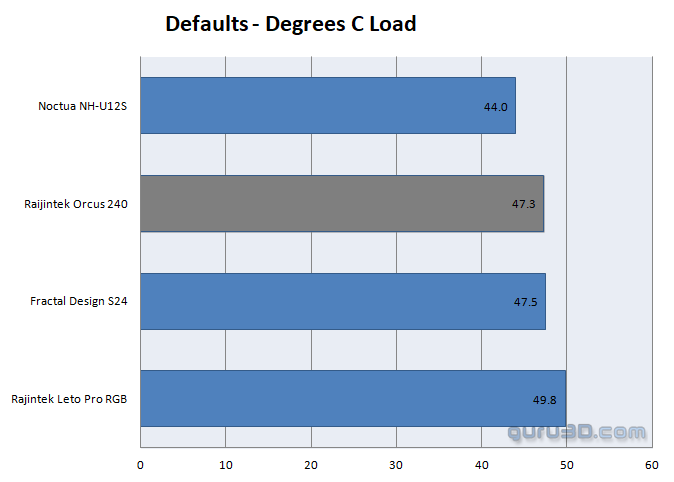Testing the cooler - stock settings
Pushing the Cooler - Stock Settings
Testing at stock settings is conducted in (as much as is reasonably possible) temperature controlled environment, meaning an ambient temperature of 21-22C is sought after before testing begins. Stock idle (and overclocked idle) temperature readings are taken after the system has had time to settle on the desktop for a few minutes, post-cold boot. Load stock and load overclock temperatures are taken at the very end of the 3rd WPrime 1024 run, when temperatures will have either saturated or been at their highest. In total, this is between 3 and 3.5m of stress testing, given that the 1700X takes approximately 1 minute and 5-10 seconds to complete a run. Naturally, we could use more runs, or use a harsher stress test like Prime95, but for most people, this is a more realistic scenario. Potential short 'bursts' of the CPU being heavily taxed. If you know that you will be using your CPU heavily (e.g. rendering, manipulating, or editing), then I would strongly suggest running a longer duration stress test in order to ensure stability. This is not mean to be an overclocking guide, after all!
Temperature readings on 'X' series Ryzen Summit Ridge CPUs are reported by some utilities with a +20C offset. At Guru3d, we report the 'TDie' temperature, or max rated package temperature without the offset, as this is what the CPU is actually running at. To reflect this, below is our chart updated for the Ryzen Generation 1 CPUs. We feel as though it gives a fairly good measure of cooler performance, and what 'level' you're getting. Naturally, if you're going to overclock, apply the same chart but to your overclocked results.
- Up to 45C - 'Enthusiast' cooling.
- 45C to 55C - 'Performance' cooling.
- 55C to 65C - 'Mainstream' cooling.
- 65C and above - 'Average' cooling.
Please remember, the above is a guideline and was only ever meant to be a guideline. Different people have different needs. If you are just gaming on your 8 core Ryzen CPU, then the thermals you will see will probably put any halfway competent cooler into the higher end of 'mainstream' category, even whilst overclocked. Naturally, if you then smack your CPU with 1.4v and push all the cores to 3.9-4.0Ghz, your previously champion level cooler will take a fairly rapid nosedive. Within the world of hard use cases for CPUs, however, there are generally accepted good practices. Ensure your chip stays below a recommended threshold, and take the time needed to make your overclock as efficient and voltage friendly as possible. Other than that, there is no more you can to ensure best practice.
Orcus 240 - Stock Cooling Performance
With all of the necessary preamble out of the way, how does the Orcus perform with a stock 95W 8-core CPU? I predicted earlier that it would either level with or just lose to the similarly priced S24 from Fractal Design, and that prediction turned out to be utterly pretty much on the money. The Orcus hit 47.3C at stock settings, essentially the same as the S24. So, at stock, a tie, and so proving that both coolers have plenty of headroom to spare.
What about noise, though? Well, it is here that we run into the most unfortunate aspect of having to use my motherboard's SYS_FAN header, rather than a dedicated CPU_FAN header or CPU_OPT. As we all know, at Guru3D, we look at the 'TDie' temperature when testing coolers, which is the CPU's temperature reported by software without the 20C offset. In reality, my 1700X was idling at around 35-36C. It would appear, sadly, that my cooler thought otherwise, kicking the fans up to the 50% range where they were evidently running as though the CPU was also in the mid to high 40's range. This was confirmed through MSI's Command Centre software. Naturally, it wasn't, but there was very little I could do to change this. As a result, noise levels at stock settings when idle and overclocked were definitely higher than they should have been. Now, to be entirely clear, here, this is not the fault of the cooler at all. I have no doubt that plugging the fans into a dedicated header would solve this issue entirely. That aside, the cooler was hitting the 34-35dBa range when running WPrime at stock settings. It should definitely have been lower, considering the equal temperature result we saw when comparing the Orcus to the S24.



